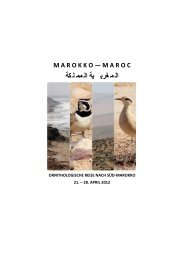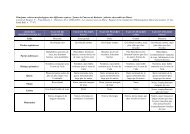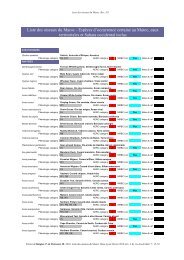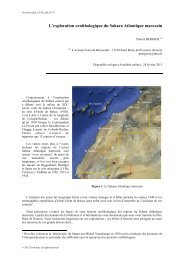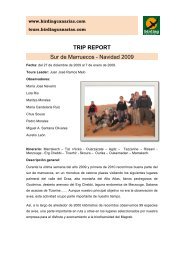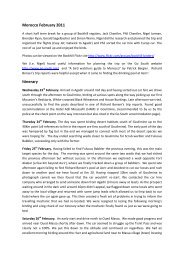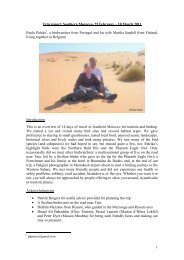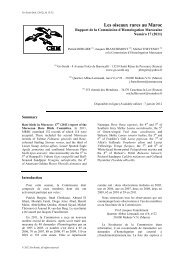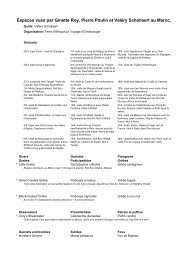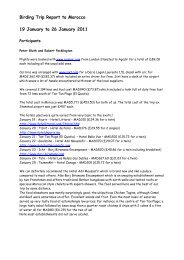Fiche de renseignements - Go-South
Fiche de renseignements - Go-South
Fiche de renseignements - Go-South
You also want an ePaper? Increase the reach of your titles
YUMPU automatically turns print PDFs into web optimized ePapers that Google loves.
TRIP REPORT MOROCCO AND WESTERN SAHARA<br />
4 th – 22 nd April 2010<br />
Morocco offers some of the best birding in the WP, so it was one of the most important<br />
<strong>de</strong>stinations for us to visit. In December 2009 we took the <strong>de</strong>cision to visit this bird-rich<br />
country in early April 2010. The group was ma<strong>de</strong> up of Sandra Götsch, Helmut Kräuter,<br />
Seppi Ringert and myself, Ernst Albegger, all for Austria.<br />
The aim of the trip was to find as many as possible of the sought-after Moroccan species, i.e.<br />
the species that in the WP can be seen only or at least most easily in Morocco. We had only<br />
14½ days for birding and wanted to cover not only the typical Moroccan regions but also the<br />
areas of Western Sahara, which have become increasingly popular over the past few years.<br />
This would require both very <strong>de</strong>tailed preparation and planning as well as many hours of<br />
driving. We started preparing in mid-January.<br />
Absolute must-haves are Patrick and Fedora Bergier’s book “A Birdwatchers’ gui<strong>de</strong> to<br />
Morocco” and Dave <strong>Go</strong>sney’s “Finding Birds in Morocco: the <strong>de</strong>serts”. For those who would<br />
like more <strong>de</strong>tailed information about the Moroccan avifauna, “The birds of Morocco” by<br />
Michel Thévenot, Rae Vernon and Patrick Bergier can be highly recommen<strong>de</strong>d. The<br />
literature we used proved very useful in combination with about 25 trip reports that we<br />
studied in quest of the perfect itinerary and to avoid wasting time searching for <strong>de</strong>tails during<br />
the trip. Four trip reports in particular are worth mentioning as the <strong>de</strong>tailed information they<br />
inclu<strong>de</strong> ma<strong>de</strong> them especially useful:<br />
Morocco 8 th -15 th March 2004, Chris Batty<br />
Morocco 2 nd -10 th April 2005, Richard Bonser<br />
<strong>South</strong>ern Morocco & West Sahara, January 2007, Lee Evans<br />
Western Sahara and <strong>South</strong>ern Morocco, 14-21 February 2008 by Thomas Pettersson,<br />
Krister Mild & Pe<strong>de</strong>r Waern<br />
Many thanks to the authors at this point!<br />
Another source that proved to be very important was Patrick Bergier’s webpage – www.gosouth.org<br />
– which can be highly recommen<strong>de</strong>d. PB himself, as well as J.L. Copete &<br />
J. Alvirez, were very helpful and kind and gave me additional information in response to a<br />
huge number of questions.<br />
04.04. Vienna - Agadir<br />
On 04 April 2010 we flew to Agadir from Vienna via Paris and Casablanca (€ 656), which<br />
was fairly expensive. We arrived at the airport at 00:45 to find that Seppi’s suitcase had been<br />
left in Casablanca. This meant that we had to return to the airport before travelling to<br />
Western Sahara. Like Chris Batty in 2004, we were lucky to find 2 singing male Red-necked<br />
Nightjars together with at least 7 Thick-Knees calling in the airport car park. Leave the airport<br />
building and go a few 100 meters to the right to the edge of the car park, then listen for these<br />
two species close to the few trees. The Red-necked Nightjars were even hunting in the area.<br />
This meant that we didn’t have to go to Oued Souss, where some people have reported<br />
problems with the guardians of the Royal Palace, which is located nearby. We hired a<br />
Citroen Berlingo (which came with an empty fuel tank), which proved to be a good vehicle for<br />
the four of us <strong>de</strong>spite two disadvantages: it had only one rear door and the windows in the<br />
back could not be opened.<br />
We drove to Oued Massa at night. The way from the airport is as follows. On leaving the<br />
airport, take the road to the left towards Agadir. At the first roundabout (after 6.4 km), go left.<br />
<strong>Go</strong> straight across the second roundabout after 4.5 km until you reach a third roundabout.<br />
Turn left here in the direction of Tiznit. Continue straight ahead for 34.1 km from this last<br />
roundabout until a sign on your right indicates “Camping International Wassay Beach”. Turn<br />
right and follow the road until you reach a T-junction, where you must turn right. Continue for<br />
several kms until you reach the Oued Massa carpark.<br />
1
If you miss the first junction to Oued Massa you need to turn right at km 36.4 from the third<br />
roundabout, which is signposted to Massa. From there, drive first straight ahead and then in<br />
a northerly direction (right of Massa and the parking lot).<br />
If you go to Oued Massa during the day, a stop after 9.2 km from the third roundabout is<br />
rewarding as on the left si<strong>de</strong> of the road several pairs of Little Swift breed in a garage by a<br />
petrol station.<br />
05.04. Oued Massa, Guelmim<br />
After about 1½ h of not very relaxing sleep we started birding at 6 o’clock. We were all<br />
fascinated by our first male Moussier’s Redstart on the building next to the carpark. This<br />
species is quite common in Oued Massa and we saw 5 m, 2 f. The distinctive sounds of<br />
Common Bulbul were all around as well as the very abundant European Serin and the quite<br />
common Linnets of race mediterranea. To our surprise, Laughing Dove was very common<br />
with many birds to be seen and heard. The first main target bird was Black-crowned<br />
Tchagra, which was found in the bushes on the right of the path to the mouth of Oued<br />
Massa about 500 m from the parking lot. This fascinating species is found more easily when<br />
you know its song.<br />
Black-crowned Tchagra, Oued Massa, 05.04.2010<br />
After about 2.5 km we reached a wall, from where we observed the water birds of Oued<br />
Massa as well as migrating passerines including one Iberian Chiffchaff. We were joined by<br />
the war<strong>de</strong>n, who wanted us to take a gui<strong>de</strong> for the critically endangered Northern Bald Ibis,<br />
which has its stronghold in Morocco (2008: 480 birds, 2010: 600 birds in 2 colonies). With the<br />
war<strong>de</strong>n’s help we twice saw a bird flying very far away on the southern si<strong>de</strong> of the Oued<br />
Massa. Although we knew that we would be able to see the bird in Tamri, we <strong>de</strong>ci<strong>de</strong>d to pay<br />
500 Moroccon Dirham (MD, ~ 45 €) for the four of us to see this charismatic species. This<br />
saved time and gave some satisfaction to the locals who work on protecting Bald Ibis.<br />
Although this represented a large sum for Morocco, it only amounted to 11 € per person for<br />
incredibly close views of the most important bird of the trip. We returned to the carpark with<br />
our French-, German- and English-speaking gui<strong>de</strong> Lahsen Ahuilat ben M’bark (Sidi R’bat,<br />
2
flamingo_290@hotmail.com, phone 00213 648108016) and drove to the second bridge over<br />
Oued Massa. Here we obtained fairly distant views of a Brown-throated (Sand) Martin<br />
(Plain Martin) of race mauretanica, a species that in the WP is restricted to Morocco. We<br />
then drove directly to the nearby site for Northern Bald Ibis to obtain incredible views of a<br />
flock of 32 birds in flight as well as feeding on the ground. The birds seemed oblivious of our<br />
car and we parked about 30 m from the flock.<br />
Northern Bald Ibis, Oued Massa, 05.04.2010<br />
After a rally through sandy tracks, where the Paris-Dakar rally used to pass through, we<br />
returned to the carpark of Oued Massa to say goodbye to our gui<strong>de</strong> and to pass the war<strong>de</strong>n<br />
some dirhams and a few pieces of our huge Easter chocolate supply as a thank-you for<br />
calling the gui<strong>de</strong>. Directly from the car park we observed a group of about 20 spoonbills<br />
when I noticed a strange-looking small white heron, which turned out to be a white morph<br />
Western Reef Heron. Afterwards we drove back along the Oued Massa, stopping just after<br />
the first village. Next to the only palm trees by the road were two breeding holes of Brownthroated<br />
Martin and we saw one bird there.<br />
We returned to the airport, stopping only for Little Swift, to pick up Seppi’s suitcase and drove<br />
directly to Guelmin (Agadir airport – Guelmin 184 km), which took us 3:50 hours. In particular<br />
the beautiful landscape of the Anti Atlas mountains is worth mentioning, although some slow<br />
lorries <strong>de</strong>layed our journey.<br />
We slept in the Hotel Bahich, which is often mentioned in birdwatching reports. It is best<br />
found by driving straight through the town until the first roundabout with traffic lights. Turn<br />
right and after about 40 m you will find the hotel on the right. The price was 180 DH for a<br />
double room without breakfast.<br />
06.04. Oued Sayed, Oued Bouhila, Sandy Plains, Khnifiss lagoon, Tarfaya<br />
We left Guelmin at 6:00 a.m. to start birding at 6:30 at Oued Sayed. We took the dirt track to<br />
the right just after the bridge and followed the track, which runs parallel to the river, until we<br />
reached some buildings on the left. We played the tape for Fulvous Babbler and within<br />
seconds we were joined by a bird, which perched on a fence just 4 m from us! We saw at<br />
least four birds in the area.<br />
3
Fulvous Babbler, Oued Sayed, 06.04.2010<br />
We continued to Oued Bouhila, which in recent years has apparently become a more reliable<br />
site for Scrub Warbler than Oued Sayed. We drove over the bridge and parked next to the<br />
road. We walked this beautiful wadi in an easterly direction for a few 100 m to find Scrub<br />
Warbler with relative ease with the help of the tape. Here we spotted our only Western<br />
Orphean and Spectacled Warbler of the trip as well as our first Rufous Bush-Robin and<br />
Trumpeter Finches.<br />
Our next stop was at the Sandy Plains at km 22 from the bridge of Guelmin mentioned in<br />
Bergier. Here we found a nesting hole of our first Red-rumped Wheatear as well as several<br />
Temmincks Horned Larks with juveniles.<br />
Temmincks Horned Lark, Sandy Plains,<br />
06.04.2010<br />
4<br />
Red-rumped Wheatear, Sandy Plains,<br />
06.04.2010<br />
Another stop at km 35 produced White Crowned and Black Wheatear, several Temmincks<br />
Horned Larks, a male Spanish Sparrow and crippling views of a pair of Thick-billed Larks.<br />
Birding at both stops was done on the east si<strong>de</strong> of the road. After finishing birding in this area<br />
at 11:30 a.m. we drove straight to Khnifiss Lagoon on road N1 with just a single brief stop
close to the sea, 50 km south of Tantan, where we saw a pair of Barbary Falcons and at<br />
least 7 Common Scoters.<br />
Sandy Plains, 06.04.2010 White-crowned Black Wheatear, Sandy<br />
Plains, 06.04.2010<br />
In Akfenir we attempted to secure a permit for Khnifiss lagoon without success as the office<br />
was closed. To reach the office, go past the fuel station on the left and turn right before<br />
passing the police station. After about 70 metres there is a big sign for the office on the left.<br />
Another opportunity to obtain the permit is to sleep at the hotel La Courbine d’Argent, where<br />
the owner can arrange permits. However, we went to the lagoon without a permit and after a<br />
brief discussion with the war<strong>de</strong>n we were allowed to stay for one hour. Despite a fairly strong<br />
wind we were able to pick out our target bird, Kelp (Cape) Gull, quickly. At least 7 adults of<br />
this much sought after species, which recently started to breed here, were present. Without a<br />
boat trip, which is sometimes offered in the area, the large lagoon is difficult to cover. For this<br />
reason we were only able to search a small part before we continued to Tarfaya.<br />
Tarfaya has a strategic position for seawatching. We went straight to the harbour and sat<br />
there for about 2 hours. This produced several Cory’s Shearwaters, Gannets, a Great Skua<br />
and an uni<strong>de</strong>ntified Dolphin. We were joined by the police but they were very friendly and<br />
smiled after looking through our scopes. When we left the harbour we were stopped by an<br />
official and had to wait for about 20 min until he had taken down all our <strong>de</strong>tails. At this point it<br />
is worth mentioning that we counted a grand total of 12 police checkpoints on our way to<br />
Dakhla, starting north of Guelmin. As suggested in other trip reports we used the attached<br />
<strong>Fiche</strong>, which we had completed in advance, and we claimed to be “biologists”. This proved a<br />
good choice because most checkpoints were passed with relative ease after showing<br />
passports and passing on the form. On our return journey north controls went much faster.<br />
In Tarfaya we stayed at the Casa Mar, a nice hotel situated close to the entrance of the<br />
harbour. When driving into Tarfaya from the north, continue straight towards the harbour<br />
instead of turning left towards Laayoune. The hotel Casa Mar is on the right just before the<br />
entery to the harbour. We paid 700 MD for dinner, bed & breakfast for all of us.<br />
07.04. Tarfaya - Dakhla<br />
We wanted to reach Dakhla and do some birding in the famous Dakhla Bay. For this reason<br />
we had to move on quickly and only stopped a couple of times. A toilet break south of<br />
Tarfaya produced a fly-by Crowned Sandgrouse. The first proper stop was ma<strong>de</strong> about 40<br />
km north of Laayoune. A lake on the left of the road held some waterbirds and a pair of<br />
Thick-billed Larks. In Laayoune we ad<strong>de</strong>d an adult female Rock Thrush and Marbled Duck<br />
to our list. A brief stop at the river passing through Laayoune can be rewarding. A rubbish<br />
dump 204 km north of Dakhla produced one pair each of Hoopoe Lark, Brown-necked<br />
Raven and Red-rumped Wheatear.<br />
At the first camping site in Dakhla Bay we searched unsuccessfully for African Royal Tern in<br />
the early afternoon and evening. A more rewarding stop was at the southernmost point of the<br />
bay (around the bridge to the harbour) where we had at least 12 European Storm Petrels<br />
as well as 100+ Audouin’s Gulls.<br />
5
Audouin’s Gull, Dakhla, 07.04.2010<br />
We stayed at Hotel Cyber, which is situated in a smaller road on the right of the main road<br />
through Dakhla. We paid 200 MD for a double room for 2 nights and had a very slow internet<br />
connection.<br />
It may be helpful to note that the northernmost roundabout of Dakhla seems to be a very<br />
popular place for the local police to hunt tourists with their speed traps. I was a victim of this<br />
game and had to pay 400 MD. Every time we drove in or out of town we saw the police<br />
standing there.<br />
08.04. Aswerd Road, Dakhla Bay<br />
To reach the famous km 41 on Aswerd road in first light, we left Dakhla at 4:15 a.m. On our<br />
way we watched a group of 4 <strong>Go</strong>l<strong>de</strong>n Jackals and some small uni<strong>de</strong>ntified hares. We<br />
witnessed a gorgeous sunrise at km 41 and soon found our target birds.<br />
Km 41 at Aswerd Road, 08.04.2010<br />
Desert Sparrows were fairly abundant in the few trees while the distinctive call of Cricket<br />
Warbler was a great help to locate the birds in the spiky grass clumps. After a brief search<br />
we found a small flock of Black-crowned Finch-Larks feeding on the sandy ground<br />
between the grass clumps. After a couple of hours we visited km 43, where we found<br />
African Dunn’s Lark close to a pair each of Desert and Bar-tailed Larks. Here we also had a<br />
Lanner Falcon and a Long-legged Buzzard of race cirtensis.<br />
6
Desert Sparrow, Oued Yenna, 08.04.2010 Black-crowned Finch-Lark, Km 41, Aswerd<br />
Road, 08.04.2010<br />
Our next stop at Oued Jenna produced more Desert Sparrows and a group of 6 Fulvous<br />
Babblers. After a short visit to the almost <strong>de</strong>serted town of Aswerd we hea<strong>de</strong>d back to km<br />
41 to obtain closer views of Desert Sparrows and Black-crowned Finch-Larks.<br />
On our way back to Dakhla we ma<strong>de</strong> a last stop on the Aswerd road at km 72 before Dakhla<br />
next to a water pond, which is supposed to be good for Crowned and Spotted Sandgrouse at<br />
9 a.m. We observed one African Rock Martin, but were too late for sandgrouse. We then<br />
drove back to Dakhla Bay where we started our search for terns at 5 p.m. We stopped at the<br />
second public beach approximately 18 km before Dakhla and found at least 6 African Royal<br />
Terns in breeding plumage along with enormous numbers of wa<strong>de</strong>rs and other waterfowl.<br />
African Royal Tern, Dakhla Bay, 08.04.2010<br />
After an extremely successful day we were very satisfied and also pleased to return safe<br />
from the area, which is potentially mined. Especially at km 41 and Oued Jenna there are<br />
many footprints of both humans and dromedaries in the sand. Nevertheless, we all felt very<br />
uneasy following the birds for some hundred meters away from the tarmac road.<br />
7
09.04. Dakhla, Echtoucan, Laayoune, Agadir, Essaouria<br />
Another early-morning start seemed necessary to see the roosting Pied Crows at<br />
Echtoucan, 106 km north of the Dakhla checkpoint. This represents only the 4 th record in the<br />
WP according to Christ Batty. We arrived there in first light after a two-hour drive and found<br />
two birds roosting on the cliffs below the pylons north-west of the petrol station. They soon<br />
took off but remained in the area of the petrol station, feeding on the rubbish. In fact, they<br />
were still there when we finished our breakfast at the café 1½ hours later.<br />
Pied Crow, Echtoucan, 09.04.2010<br />
Except for one brief stop in Laayoune, which produced several waterfowl including Marbled<br />
Duck and a single Little Swift, we pushed on north to Essaouira, which meant a 1400 km<br />
journey in a single day. We arrived in Essaouira at 11 p.m. Together with Helmut I tried<br />
unsuccessfully for 1½ hours to locate Maghreb Tawny Owl, which was reported in 2009 from<br />
the trees close to the harbour (see the map by Javier Alvirez below). We stayed at the hotel<br />
Dar Naciria (58, Bd. Med V Essaouria, essa@darnaciria.net, www.darnaciria.net, phone<br />
00212 24784504) and paid 400 MD per double room including breakfast.<br />
Maghreb Tawny Owl map<br />
8
10.04. Essaouria surroundings, Oualidia<br />
After a long day (21 hours) the previous day we treated ourselves to a lie-in and slept until 7<br />
a.m. After breakfast we spent until midday exploring the surroundings of Essaouira including<br />
the beach, which produced a dark-morph Western Reef Heron, a rare bird in Morocco, and<br />
a male Cirl Bunting but little else. It was too early for the most famous bird attraction of the<br />
town, Eleonora’s Falcon, which breeds in huge numbers on the offshore islands. Despite a<br />
careful search we were not able to locate any of the rare Shags of race riggenbachi.<br />
Birding on Essaouria beach, 10.04.2010<br />
After a nice lunch in the fascinating scenery of the old part of Essaouria and won<strong>de</strong>rful views<br />
of very tame House Buntings we continued north to Oualidia, where we bir<strong>de</strong>d for a couple<br />
of hours and ad<strong>de</strong>d a few species such as Blue Rock Thrush to our trip list. We slept at<br />
Motel-Restaurant A L’Aragnée <strong>Go</strong>urman<strong>de</strong> and paid 250 MD for a double room. Our<br />
sleeping rooms were situated next to the restaurant on the southwest edge of the lagoon<br />
rather than in the centre of town. To reach the hotel, drive along the road towards the beach.<br />
The hotel is on the right of the road opposite a kiosk. It can be highly recommen<strong>de</strong>d because<br />
of its friendly owner and because of the pleasant rooms.<br />
11.04. Oualidia surroundings, Marrakesh<br />
On the following morning we explored the lagoons south of Oualidia, finding a second<br />
calendar year Grey Phalarope together with good numbers of waterfowl. After a late<br />
breakfast in the restaurant, where we kept an eye on the gull and tern roost in the lagoon of<br />
Oualidia, we ma<strong>de</strong> our way towards Marrakesh, finding an impressive <strong>de</strong>nsity of Calandra<br />
Larks and Corn Buntings on the way, many of which were already feeding chicks, along with<br />
several Collared Pratincoles and Little Owls. As the roads were pretty bad and we had no<br />
reason to hurry we did not arrive in Marrakesh until fairly late in the afternoon. We stayed at<br />
a hotel at the southern end of Marrakesh on the main road to Oukaime<strong>de</strong>n to have a good<br />
strategic position for an early-morning start to the famous ski resort the next day. We took a<br />
taxi back into Marrakesh and spent the evening around the famous square Djemaa el-Fna<br />
wan<strong>de</strong>ring through the souks. Another attempt to find Maghreb Tawny Owl failed because of<br />
the incredibly noisy nightlife in this fascinating town.<br />
12.04. Oukaime<strong>de</strong>n, Toufliath Forest House, Tizi n’Tichka Pass, Boumalne <strong>de</strong><br />
Da<strong>de</strong>s<br />
An early-morning start (4 a.m.) was necessary to reach Oukaime<strong>de</strong>n ski resort at first light.<br />
The area is situated in the High Atlas at an altitu<strong>de</strong> of 2600 metres.<br />
9
Oukaime<strong>de</strong>n, 12.04.2010<br />
Unsurprisingly it was quite cold in the early morning but it warmed up quickly when the sun<br />
came out. Our main target bird, Crimson-winged Finch, showed well at car park 2 (80+<br />
birds), followed by Seebohm’s Wheatear, Rock Sparrow, Red-billed Chough, Alpine<br />
Chough and Mistle Thrush as well as a superb male Moussier’s Redstart, several Shore<br />
Larks of race atlas and a male Blue Rock Thrush. Oukaime<strong>de</strong>n also offers a chance to see<br />
Bear<strong>de</strong>d Vulture but although a bird had been seen a few days before we were out of luck.<br />
Crimson-winged Finch, 12.04.2010 Seebohm’s Wheatear, 12.04.2010<br />
Shore Lark ssp. atlas, 12.04.2010 Moussier’s Redstart, 12.04.2010<br />
After a hearty breakfast in the gorgeous mountain scenery next to the highest peak of North<br />
Africa, the Djebel Toubkal (4167 m), we hea<strong>de</strong>d down to the two pylons located next to the<br />
road at 2233 m (31° 14’ 14.8’’ N 007° 48’ 59,7’’ W). I was very relieved when we got out of<br />
the car at 09:30 a.m. and found a superb male Tristram’s Warbler singing: the species can<br />
be quite tricky to see. At this spot we also had a pair of Barbary Partridges and 6 Alpine<br />
Swifts. On our way down we heard 2 distant Levaillant’s (Green) Woodpeckers calling but<br />
failed to locate them. We did encounter a pair of Booted Eagle (pale morph), Firecrest of<br />
race balearicus, our only Red-rumped Swallows of the trip and another male Moussier’s<br />
Redstart.<br />
10
We <strong>de</strong>ci<strong>de</strong>d to avoid the Marrakesh traffic and so took the shortcut to Ait Ounir. We<br />
continued to the Toufliath forest house, where we heard another distant Levaillant’s (Green)<br />
Woodpecker. The long and winding drive to the Tizi n’Tickha Pass produced our only Shorttoed<br />
Eagle of the trip. At the pass we saw another male Seebohm’s Wheatear. After the<br />
pass the road was less windy and so we reached Ouazarzate and the Mamsour Eddahbi<br />
dam much earlier than expected.<br />
Tizi n’Tickha Pass, 12.04.2010<br />
At km 15 after Ouarzazate we took the tarmac road to the lake to find 4 Marbled Ducks and<br />
at least 6 Ruddy Shelducks but little else. We then hea<strong>de</strong>d to Boumalne <strong>de</strong> Da<strong>de</strong>s, where<br />
we stayed at the Hotel Le Soleil Bleu (phone 00212 24830163). To reach this hotel when<br />
coming from Ouarzazate continue on the road to Er-Rachidia. Immediately before leaving<br />
Boumalne <strong>de</strong> Da<strong>de</strong>s you will see a petrol station on your left. Immediately before this, turn<br />
left onto a small tarmac road that turns into a gravel road after a few hundred meters. You<br />
pass another hotel to find the Auberge le Soleil Bleu. We paid 300 MD per person for dinner,<br />
bed and a packed breakfast.<br />
13.04. Tagdilt Track, Todra <strong>Go</strong>rge, Rissani<br />
We spent five hours on the famous Tagdilt Track to find a female Maghreb Wheatear<br />
together with 5 other species of wheatear at the “wheatear wall” (31.3104 N, 5.9007 W).<br />
11
Tagdilt Track, 13.04.2010<br />
The best way to reach this point is by following the tarmac road to Ikniouen. Other species<br />
inclu<strong>de</strong>d Black-bellied Sandgrouse (2), Cream-coloured Courser (30+), Hoopoe Lark (3),<br />
Bar-tailed Desert Lark (1), Desert Lark (1), Temminck’s Horned Lark (30+), Desert<br />
Wheatear (10+), Red-rumped Wheatear (5+), House Bunting (1 ♂) and Trumpeter Finch<br />
(8+). The drinking ponds were dry. Afterwards we continued to the scenic Todra gorge,<br />
where it was already midday and where we failed to see Bonelli’s Eagle.<br />
Maghreb Wheatear, 13.04.2010 Red-rumped Wheatear, 13.04.2010<br />
Cream-coloured Courser, 13.04.2010 House Bunting, 13.04.2010<br />
We ma<strong>de</strong> our way to Rissani, where we met our gui<strong>de</strong> Brahim Mezane (phone 00212<br />
670181130, <strong>de</strong>sertbirds.live.fr), a young and enthusiastic local. He showed us an adult<br />
12
Pharaoh Eagle Owl with three chicks at a different location from the well known site. The big<br />
advantage was that we simply got out of the car and saw the birds. We paid him 150 MD. On<br />
the way back to Rissani we found a pair of Moroccan White Wagtails (race subpersonata)<br />
upstream from the river that is crossed when coming into Rissani. In Rissani we ad<strong>de</strong>d Bluecheecked<br />
Bee-eater to our list.<br />
The final stop of the day was at Auberge Le Caravane, which is situated about 1 km from the<br />
famous Auberge Yasmina and Morocco’s biggest sand dune system, Erg Chebbi. We<br />
immediately found its owner Ibrahim (phone 00212 666 039175, kadi1974@hotmail.com),<br />
who is said to be one of the most reliable gui<strong>de</strong>s for the endangered Houbara Bustard. This<br />
enigmatic species was hunted close to extinction by Saudi falconers in the 1980s but in<br />
recent years birds have been regularly seen in the stony <strong>de</strong>sert north and east of the Erg<br />
Chebbi. We paid 250 MD per person for dinner, bed and breakfast. Our final arrangement<br />
was to pay Ibrahim 1400 MD for a four-wheel drive tour if we saw the bustard and 500 MD if<br />
we failed.<br />
14.04.<br />
On the following morning we went out with Ibrahim’s brother at 05:30 a.m. Ibrahim was busy<br />
and we had had no contact <strong>de</strong>tails to reserve him in advance. Ibrahim told us he had seen a<br />
bustard four days ago. Despite carefully searching the stone <strong>de</strong>serts north of Erg Chebbi<br />
until 09:30 a.m. we were not able to find our target bird. By this time it was clear that we were<br />
out of luck and we returned in poor spirit to the auberge, where a large breakfast cheered us<br />
up. Birds seen on the drive inclu<strong>de</strong>d 5+ Cream-coloured Coursers, 8+ Hoopoe Larks,<br />
which we heard singing everywhere, 2 Desert Larks and 4 Brown-necked Ravens. We<br />
twice heard Black-bellied Sandgrouse calling, but couldn’t locate them.<br />
After breakfast we left the auberge and found at least 20 Brown-necked Ravens feeding in<br />
the rubbish close by. We visited the Spanish ringing station at Auberge Yasmina but<br />
migration was very slow and not many birds were caught. At 12 o’clock we tried the Desert<br />
Warbler site <strong>de</strong>scribed by Dave <strong>Go</strong>sney about 8 km west of Auberge Caravan. We started to<br />
search for this bird about 600 m east of the GPS point 31.2415 N, 4.0834 W and were very<br />
surprised to find a pair of African Dunn’s Larks at close range. This species is restricted to<br />
the southern Western Sahara and according to Patrick Bergier this is the first record for<br />
Morocco apart from the Western Sahara. I immediately sent a text message to Patrick<br />
Bergier and on the same day some other bir<strong>de</strong>rs were able to twitch the lark. Exactly at the<br />
GPS point a singing African Desert Warbler and another bird (probably female) were<br />
located.<br />
African Dunn’s Lark, Merzouga area,<br />
14.04.2010<br />
13<br />
In search of African Desert Warbler,<br />
Merzouga area, 14.04.2010<br />
Our next stop was the famous Auberge Derkaoua, which used to be the place for Egyptian<br />
Nightjar. We searched the wadi north of the auberge for this species and Sahara Olivaceous<br />
Warbler but in vain. Our search was complicated by the onset of a sandstorm, which lasted<br />
until night time. The situation was the same at Auberge Tresor, the most reliable place for
Egyptian Nightjar in recent years, and after a brief search there we <strong>de</strong>ci<strong>de</strong>d to return to<br />
Auberge La Caravan.<br />
After a one-hour break we went on another four-wheel drive at 4 p.m. and searched until<br />
nightfall for Houbara Bustard in the stony <strong>de</strong>sert east of Erg Chebbi, reaching very close to<br />
the Algerian bor<strong>de</strong>r. The sandstorm wasn’t helpful and unfortunately we were again<br />
unsuccessful. We stayed a second night at Auberge Le Caravane – two of us in a berber<br />
tent, a nice experience.<br />
15.04. Rissani, Hassan Addakhil, Zeida Plains<br />
Yesterday’s sandstorm had quietened down and so we left Auberge Le Caravane at 4 a.m.<br />
to try our luck with the Egyptian Nightjar at the new hotspot at Auberge Tresor. We heard 1<br />
bird in first light but didn’t manage to see it.<br />
We continued to Rissani, where we walked along the Oued Ziz. This dried out river bed is<br />
mentioned by <strong>Go</strong>sney as the most reliable site for Saharan Olivaceous Warbler (race<br />
reiseri), which is sometimes thought to be a separate species. After searching for the species<br />
north of the bridge without success - although at least 12 Blue-cheecked Bee-eaters and<br />
one Moroccan White Wagtail (race subpersonata) were some consolation - we located 3<br />
singing birds in the tamarisks south of the bridge.<br />
After a <strong>de</strong>lightful breakfast in Rissani we searched for our final target bird in the area, Longbilled<br />
Crested Lark race macrorhyncha. This subspecies is often treated as a separate<br />
species and we found it to be quite common along the drainage channels next to the road to<br />
the well-known site for Pharaoh Eagle Owl.<br />
Saharan Olivaceous Warbler, Rissani,<br />
15.04.2010<br />
14<br />
Long-billed Crested Lark, Rissani,<br />
15.04.2010<br />
We continued north towards Mi<strong>de</strong>lt with several stops along the way, including a quick swim<br />
at the beautiful Source Bleue <strong>de</strong> Meski near Er-Rachidia and some birding at the famous<br />
dam at Hassan Addakhil, where we had a small flock of Greater Flamingos, Ruddy<br />
Shelducks and 5 Marbled Ducks.<br />
We arrived at the Zeida plains in the late afternoon, where we visited a site mentioned by<br />
<strong>Go</strong>sney. Three km south of Zeida we turned right at the crossroads between two bends,<br />
close to the km post that says “Er Rachidia 167” and “Meknes 162”. We stopped after a few<br />
hundred metres along this track (32.7944 N 4.9335 W) and searched for Dupont’s Lark in<br />
light rain. Our hopes were low due to the bad weather and the late time of the day but after a<br />
brief but heavy thun<strong>de</strong>rstorm the sun came out. We were very pleased to hear 5-8 birds<br />
singing, together with 20+ Lesser Short-toed Larks and 15+ Greater Short-toed Larks. After a<br />
long hunt, we managed to get brief views of 2 Dupont’s Larks, which proved extremely<br />
difficult to locate although they were singing directly in front of us. We stayed at the nearby<br />
Hotel Timnay, which turned out to be good value. Although it was not the cheapest hotel, it<br />
can be highly recommend and keeps a birding logbook. It is located about 2 km south of the<br />
junction to the track for the larks on the left when coming from the north. We spent a pleasant<br />
evening at the hotel.
16.04. Zeida Plains, Azrou, Ifrane, Sidi Yaya – Sidi Bettache, Temara<br />
Zeida Plains, 15.04.2010<br />
I felt sick during the night and so did not join Seppi and Helmut in their hunt for Dupont’s<br />
Lark at first light. They found 5 birds at the same spot and enjoyed excellent views of this<br />
highly elusive species.<br />
Dupont’s Lark, Zeida Plains, 16.04.2010<br />
After breakfast we hea<strong>de</strong>d on north towards Ifrane. Our main targets were Atlas Pied<br />
Flycatcher and Levaillant’s (Green) Woodpecker, which we had so far only heard. On our<br />
way we ad<strong>de</strong>d 2 adult Egyptian Vultures to our list and encountered 3 Seebohm’s<br />
Wheatears. We were surprised to find huge numbers of White Storks at a high altitu<strong>de</strong> of up<br />
to 2000 metres feeding by small lakes or in open grasslands. A few kilometres south of<br />
Azrou we stopped by chance and were lucky to find a male Levaillant’s (Green)<br />
Woodpecker immediately in an oak forest. Although we put some effort into locating an early<br />
Atlas Pied Flycatcher we failed to see the species, which is hardly surprising as the first<br />
individuals do not normally arrive until the end of April.<br />
15
We then visited the well known breeding site for Lesser Kestrel just south of Ifrane, where<br />
about 50 birds were hunting for insects at close range. This stop also produced 3 Booted<br />
Eagles (including a pair on a nest) and Black Kites. We continued to Rabat, seeing several<br />
hundred Cattle Egrets on the way. We explored the area between Sidi Yaya and Sidi<br />
Bettache in the afternoon to get a first impression of this famous site for one of the most<br />
sought-after Moroccon species, the enigmatic Double-spurred Francolin. We found 3<br />
Black-shoul<strong>de</strong>red Kites, 1 Booted Eagle and 1 Woodchat Shrike. We struggled to find a<br />
hotel south of Rabat but finally located the Hotel Panorama (www.panoramasabledor.com) in<br />
Témara Plage.<br />
17.04. Sidi Yaya – Sidi Bettache, Lac <strong>de</strong> Sidi Boughaba, Merja Zerga<br />
We had to get up at 4 a.m. to be at the Double-spurred Francolin site at the parking lot<br />
south of the hunting reserve between Sidi Yaya and Sidi Bettache before dawn. But this was<br />
in vain and we were out of luck this morning. We finally gave up at 7:15 a.m. having only<br />
seen a pair of Barbary Patridge.<br />
Disappointed, we hea<strong>de</strong>d north to Lac di Sidi Boughaba, where several White-hea<strong>de</strong>d<br />
Ducks (3 adult males, 3 immature males and 1 adult female), 15 Crested Coots with 10 pulli<br />
and 2 adult Purple Gallinules were on the southern part of the lake. Other species inclu<strong>de</strong>d<br />
Ferruginous Ducks, Marbled Ducks and Little Tern.<br />
White-hea<strong>de</strong>d Duck, Lac <strong>de</strong> Sidi Boughaba, 17.04.2010<br />
We had a late breakfast at the Port di Sidi Boughaba, where we also did some seawatching,<br />
which produced Gannets, Sandwich Terns, Cory’s Shearwaters and a distant uni<strong>de</strong>ntified<br />
small Skua species.<br />
16
Marbled Duck, Lac <strong>de</strong> Sidi Boughaba, 17.04.2010<br />
Our next stop was Café Milano in Moulay Bousselham, where we asked for the famous gui<strong>de</strong><br />
Hassan Dalil (phone 00212 668434110). Please note that the phone number given in the<br />
recent edition of Lonely Planet is wrong. Hassan was quickly summoned by the café’s owner<br />
and we arranged to go out with him in the evening to look for Marsh Owl. In the WP, this<br />
<strong>de</strong>clining species is restricted to Morocco, where it is critically endangered with just 25 pairs<br />
left. According to Hassan, its stronghold is Merja Zerga and in 2010 there were just 1-2<br />
additional pairs in the area of Larache and one pair at Lac <strong>de</strong> Sidi Boughaba. Hassan<br />
arranged two rooms at the Villa Nora (250 MD per person for b&b) for us, which was not the<br />
cheapest place to stay. Hassan’s fee was also quite hefty: he charged 800 MD to take us to<br />
the Marsh Owl site in the south west of Merja Zerga. Still, it was well worth it as he found us<br />
a beautiful roosting specimen. There were also large numbers of wa<strong>de</strong>rs feeding in the mud<br />
plains, unfortunately fairly distant. We recor<strong>de</strong>d Black-winged Stilts, Collared Pratincoles,<br />
250+ Grey Plovers, 150+ Dunlins, 20+ Curlew Sandpipers, 1 Red Knot, 100+ Gull-billed<br />
Terns and 1 Iberian Yellow Wagtail. Satisfied with the result of our evening excursion we<br />
hea<strong>de</strong>d back to Moulay Bousselham and a great dinner at Café Milano.<br />
17
Marsh Owl, Merja Zerga, 17.04.2010<br />
18.04. Merja Zerga, Larache (Lower Loukkos), Temara<br />
After a leisurely breakfast on the hotel veranda, we met Hassan at 8 a.m. by the harbour. We<br />
had arranged to take a boat trip to the lagoon of Merja Zerga. Heavy rain forced us to <strong>de</strong>lay<br />
our <strong>de</strong>parture but after approximately 20 minutes the rain stopped and we hea<strong>de</strong>d out. Our<br />
main target bird was Lesser Crested Tern. The first bird had arrived two days earlier. We<br />
went to a sand bank and struck lucky when we found one bird roosting among Sandwich<br />
Terns.<br />
Lesser Crested Tern, Merja Zerga, 18.04.2010<br />
Soon the skies opened up again and we retreated to the shore where we waited un<strong>de</strong>r a tree<br />
for the rain to stop. After an hour the rain subsi<strong>de</strong>d and we returned to the lagoon. While we<br />
18
were watching some wa<strong>de</strong>rs, gulls and terns, the heavy rain started again and we finally<br />
gave up. Despite waterproof clothes we were soaking wet and nee<strong>de</strong>d to change. We paid<br />
Hassan 600 MD for the four of us and left Moulay Bousselham heading north.<br />
At midday we arrived at Larache and explored the wi<strong>de</strong> wetland areas east of town. We<br />
bir<strong>de</strong>d at a relaxed pace, feeling that we <strong>de</strong>served some time relaxing after such a strenuous<br />
trip. The sun came out and we were treated to good views of a variety of birds including<br />
Great White Egret, Little Bittern, Marbled Duck, Crested Coot, Lesser Kestrel, 100+<br />
Collared Pratincoles, Peregrine, 6 Gull-billed Terns, Skylark (rare at this time of the year in<br />
Morocco, two birds singing), 1 Brown-throated Martin and Cetti’s Warbler. On our return<br />
drive to Larache we received a text message saying that our return flights for the next day<br />
had been cancelled due to the volcanic eruption in Iceland and the resulting dust clouds over<br />
Europe. We still had to return to Rabat to drop our car off at the airport the next day. We<br />
were unable to learn anything about the flight situation in the following days and we returned<br />
to Hotel Panorama in Temara in low spirits.<br />
19.04. Sidi Yaya – Sidi Bettache, Rabat Airport, Tanger<br />
Another early morning start was necessary for a second attempt at Double-spurred<br />
Francolin. We arrived in the dark at the carpark but <strong>de</strong>spite waiting for the first light we again<br />
failed to find the bird. It seems that the car park wasn’t a good spot this year, as the same<br />
happened to a group of Dutch and two Finnish bir<strong>de</strong>rs we met during our trip. But thanks to<br />
Andreas Uppstu (one of the Finnish bir<strong>de</strong>rs), who sent us directions to another site for our<br />
target bird, all was not lost. At 33.708682°N 6.921912°W we ma<strong>de</strong> another stop and 20<br />
minutes after dawn we were electrified to hear a Double-spurred Francolin calling. In the<br />
end we counted 7 different birds calling from this point in the valley to the east of the road but<br />
although the birds called for at least 1½ hours and we <strong>de</strong>sperately tried to locate one we<br />
failed (like all the other bir<strong>de</strong>rs that we met).<br />
We returned to the hotel and had breakfast before driving to Rabat airport to return our rental<br />
car. From there we took a taxi to Tangiers having learned that all Moroccan airports were to<br />
remain closed for the next four days. After lengthy negotiations we secured a price of 1200<br />
MD to Tangiers port. During the drive to Tangiers we ad<strong>de</strong>d Roller as the final new species<br />
for our trip list in Morocco.<br />
At the port of Tangiers we had to accept that the only possibility to return to Austria was the<br />
ferry via Barcelona to Genova, which took us nearly 3 days. Other i<strong>de</strong>as, such as taking a<br />
ferry to Spain, had to be abandoned because of the lack of rental cars and overbooked<br />
trains.<br />
20.04. – 22.04. Ferry Tanger, Barcelona, Genoa, Udine, Klagenfurt, Graz/Vienna<br />
On the evening of 20 April we saw a group of 15 Storm Petrels off the eastern Spanish<br />
coast. We were not allowed to leave the ship during our stop in Barcelona on 21 April but still<br />
managed to see 8 Monk Parakeets and 4 Ring-necked Parakeets. Later on in the evening<br />
we saw a pelagic flock of 31 Little Gulls off the Spanish Coast. We arrived in Genova on<br />
22 April and ma<strong>de</strong> our way back to Austria via rental car and train.<br />
Although our return trip was a nightmare, the trip was incredibly successful with 233 species<br />
including 24 WP ticks for me personally and just one dip, Atlas Pied Flycatcher, which was<br />
hardly unexpected.<br />
19
<strong>Fiche</strong> <strong>de</strong> <strong>renseignements</strong><br />
Pour chaque voyageur, préciser :<br />
Etat Civil<br />
Nom<br />
Prénom<br />
Date <strong>de</strong> naissance<br />
Lieu <strong>de</strong> naissance<br />
Prénom/Nom du père<br />
Prénom/Nom <strong>de</strong> la mère<br />
Situation familiale<br />
Nombre d'enfants<br />
Nationalité<br />
Profession<br />
Adresse<br />
Passeport<br />
N°<br />
Délivré le<br />
A<br />
Date d'expiration<br />
Voyage<br />
Motif du voyage<br />
Date d'entrée au Maroc<br />
Ville d'entrée<br />
Venant <strong>de</strong><br />
Allant à<br />
Véhicule<br />
Voiture (type/marque)<br />
N° d'immatriculation<br />
20
Complete Trip List<br />
1. Zwergtaucher Tachybaptus ruficollis ruficollis Little Grebe<br />
2. Haubentaucher Podiceps cristatus cristatus Great Crested Grebe<br />
3. Schwarzhalstaucher Podiceps nigricollis nigricollis Black-necked Grebe<br />
4. Gelbschnabelsturmtaucher Calonectris diome<strong>de</strong>a Cory`s Shearwater<br />
5. Sturmschwalbe Hydrobates pelagicus European Storm Petrel<br />
6. Baßtölpel Sula bassana bassana Gannet<br />
7. Kormoran Phalacrocorax carbo maroccanus Cormorant<br />
Phalacrocorax carbo sinensis<br />
8. Graureiher Ar<strong>de</strong>a cinerea cinerea Grey Heron<br />
9. Purpurreiher Ar<strong>de</strong>a purpurea purpurea Purple Heron<br />
10. Silberreiher Egretta alba alba Great White Egret<br />
11. Sei<strong>de</strong>nreiher Egretta garzetta garzetta Little Egret<br />
12. Küstenreiher Egretta gularis gularis Western Reef Heron<br />
13. Kuhreiher Bubulcus ibis ibis Cattle Egret<br />
14. Rallenreiher Ar<strong>de</strong>ola ralloi<strong>de</strong>s Squacco Heron<br />
15. Nachtreiher Nycticorax nycticorax nycticorax Night Heron<br />
16. Zwergdommel Ixobrychus minutus minutus Little Bittern<br />
17. Schwarzstorch Ciconia nigra Black Stork<br />
18. Weißstorch Ciconia cicoria ciconia White Stork<br />
19. Waldrapp Geronticus eremita Northern Bald Ibis<br />
20. Löffler Platalea leucorodia leucorodia Spoonbill<br />
21. Rosa Flamingo Phoenicopterus rubber roseus Greater Flamingo<br />
22. Graugans Anser anser anser Greylag <strong>Go</strong>ose<br />
23. Rostgans Tadorna ferruginea Ruddy Shelduck<br />
24. Schnatterente Anas strepera strepera Gadwall<br />
25. Stockente Anas platyrhynchos platyrhynchos Mallard<br />
26. Löffelente Anas clypeata Shoveler<br />
27. Marmelente Marmaronetta angustirostris Marbled Duck<br />
28. Kolbenente Netta rufina Red-crested Pochard<br />
29. Tafelente Aythya ferina Pochard<br />
30. Moorente Aythya nyroca Ferruginous Duck<br />
31. Reiherente Aythya fuligula Tufted Duck<br />
32. Trauerente Melanitta nigra nigra Black Scoter<br />
33. Weißkopfru<strong>de</strong>rente Oxyura leucocephala White-hea<strong>de</strong>d Duck<br />
34. Fischadler Pandion haliaetus haliaetus Osprey<br />
35. Gleitaar Elanus caeruleus caeruleus Black-shoul<strong>de</strong>red Kite<br />
36. Schwarzmilan Milvus migrans migrans Black Kite<br />
37. Schmutzgeier Neophron percnopterus percnopterus Egyptian Vulture<br />
38. Schlangenadler Circaetus gallicus gallicus Short-toed Eagle<br />
39. Kornweihe Circus cyanus cyaneus Hen Harrier<br />
40. Wiesenweihe Circus pygargus Montagu`s Harrier<br />
41. Rohrweihe Circus aeruginosus aeruginosus Marsh Harrier<br />
Circus aeruginosus harterti<br />
42. Habicht Accipiter gentilis gentilis <strong>Go</strong>shawk<br />
43. Adlerbussard Buteo rufinus cirtensis Long-legged Buzzard<br />
44. Zwergadler Hieraaetus pennatus Booted Eagle<br />
45. Rötelfalke Falco naumanni Lesser Kestrel<br />
46. Turmfalke Falco tinnunculus tinnunculus Kestrel<br />
47. Baumfalke° Falco subbuteo Hobby<br />
48. Lannerfalke Falco biarmicus erlangeri Lanner<br />
49. Wan<strong>de</strong>rfalke Falco peregrinus minor Peregrine<br />
50. Wüstenfalke Falco pelegrinoi<strong>de</strong>s pelegrinoi<strong>de</strong>s Barbary Falcon<br />
51. Felsenhuhn Alectoris Barbara barbara Barbary Patridge<br />
52. Doppelspornfrankolin Francolinus bicalcaratus ayesha Double-spurred Francolin<br />
53. Wachtel Coturnix coturnix coturnix Quail<br />
21
54. Laufhühnchen Turnix sylvatica sylvatica Little Buttonquail<br />
55. Teichhuhn Gallinula chloropus chloropus Moorhen<br />
56. Purpurhuhn Porphyrio porphyrio porphyrio Purple Gallinule<br />
57. Bläßhuhn Fulica atra atra Coot<br />
58. Kammbläßhuhn Fulica cristata Crested Coot<br />
59. Austernfischer Haematopus ostralegus ostralegus Oystercatcher<br />
60. Stelzenläufer Himantopus himantopus himantopus Black-winged Stilt<br />
61. Säbelschnäbler Recurvirostra avosetta Avocet<br />
62. Triel Burhinus oedicnemus saharae Stone Curlew<br />
63. Rennvogel Cursorius cursor cursor Cream-coloured Courser<br />
64. Rotflügelbrachschwalbe Glareola pratincola pratincola Collared Pratincole<br />
65. Kiebitz Vanellus vanellus Lapwing<br />
66. Kiebitzregenpfeifer Pluvialis squatarola Grey Plover<br />
67. Sandregenpfeifer Charadrius hiaticula Ringed Plover<br />
68. Flußregenpfeifer Charadrius dubius curonicus Little-ringed Plover<br />
69. Seeregenpfeifer Charadrius alexandrinus alexandrinus Kentish Plover<br />
70. Pfuhlschnepfe Limosa lapponica lapponica Bar-tailed <strong>Go</strong>dwit<br />
71. Regenbrachvogel Numenius phaeopus phaeopus Whimbrel<br />
72. Großer Brachvogel Numenius arquata arquata Curlew<br />
73. Rotschenkel Tringa totanus Redshank<br />
74. Grünschenkel Tringa nebularia Greenshank<br />
75. Waldwasserläufer Tringa ochropus Green Sandpiper<br />
76. Flußuferläufer Actitis hypoleucos Common Sandpiper<br />
77. Steinwälzer Arenaria interpres interpres Turnstone<br />
78. Thorshühnchen Phalaropus fulicarius Grey Pharalope<br />
79. Bekassine Gallinago gallinago gallinago Common Snipe<br />
80. Knutt Calidris canutus canutus Knot<br />
81. San<strong>de</strong>rling Calidris alba San<strong>de</strong>rling<br />
82. Zwergstrandläufer Calidris minuta Little Stint<br />
83. Alpenstrandläufer Calidris alpina Dunlin<br />
84. Sichelstrandläufer Calidris ferruginea Curlew Sandpiper<br />
85. Kampfläufer Philomachus pugnax Ruff<br />
86. Skua Stercorarius skua skua Great Skua<br />
87. Schmarotzerraubmöwe Stercorarius parasiticus Arctic Skua<br />
88. Korallenmöwe Larus audouinii Audouin`s Gull<br />
89. Kapmöwe Larus vetula Cape Gull<br />
90. Mittelmeermöwe Larus michahellis michahellis Yellow-legged Gull<br />
91. Heringsmöwe Larus fuscus graellsii Lesser Black-backed Gull<br />
92. Schwarzkopfmöwe Larus melanocephalus Mediterranean Gull<br />
93. Lachmöwe Larus ridibundus Black-hea<strong>de</strong>d Gull<br />
94. Dünnschnabelmöwe Larus genei Slen<strong>de</strong>r-billed Gull<br />
95. Zwergmöwe Larus minutes Little Gull<br />
96. Lachseeschwalbe Gelochelidon nilotica nilotica Gull-billed Tern<br />
97. Raubseeschwalbe Sterna caspia Caspian Tern<br />
98. Flußseeschwalbe Sterna hirundo hirundo Common Tern<br />
99. Zwergseeschwalbe Sterna albifrons albifrons Little Tern<br />
100. Königsseeschwalbe Sterna maxima albididorsalis Royal Tern<br />
101. Rüppellseeschwalbe Sterna bengalensis torresii Lesser Crested Tern<br />
102. Brandseeschwalbe Sterna sandvicensis sandvicensis Sandwich Tern<br />
103. Sandflughuhn Pterocles orientalis orientalis Black-bellied Sandgrouse<br />
104. Kronenflughuhn Pterocles coronatus coronatus Crowned Sandgrouse<br />
105. Felsentaube Columba livia livia Rock Dove<br />
106. Hohltaube Columba oenas oenas Stock Dove<br />
107. Ringeltaube Columba palumbus excelsa Woodpigeon<br />
108. Turteltaube Streptopelia turtur Turtle Dove<br />
109. Türkentaube Streptopelia <strong>de</strong>caocto <strong>de</strong>caocto Collared Dove<br />
110. Palmtaube Streptopelia senegalensis Laughing Dove<br />
111. Halsbandsittich° Psittacula crameri Ring-necked Parakeet<br />
22
112. Mönchssittich° Myiopsitta monachus Monk Parakeet<br />
113. Kuckuck Cuculus canorus Cuckoo<br />
114. Wüstenuhu Bubo ascalaphus <strong>de</strong>sertorum Pharaoh Eagle Owl<br />
115. Steinkauz Athene noctua glaux Little Owl<br />
Athene noctua saharae<br />
116. Kapohreule Asio capensis tingitanus Marsh Owl<br />
117. Rothalsziegenmelker Caprimulgus ruficollis ruficollis Red-necked Nightjar<br />
118. Ziegenmelker Caprimulgus europaeus Nightjar<br />
119. Pharaonenziegenmelker Caprimulgus aegyptius saharae Egyptian Nightjar<br />
120. Alpensegler Apus melba Alpine Swift<br />
121. Fahlsegler Apus pallidus brehmorum Pallid Swift<br />
122. Haussegler Apus affinis galilejensis Little Swift<br />
123. Eisvogel Alcedo atthis atthis Kingfisher<br />
124. Blauwangerspint Merops persicus chrysocercus Blue-cheeked Bee-eater<br />
125. Bienenfresser Merops apiaster apiaster Bee-eater<br />
126. Blauracke Coracias garrulous garrulous Roller<br />
127. Wie<strong>de</strong>hopf Upupa epops epopos Hoopoe<br />
128. Wen<strong>de</strong>hals Jynx torquilla Wryneck<br />
129. Buntspecht (Maurenspecht) Picoi<strong>de</strong>s major mauritanus Great Spotted Woodpecker<br />
130. Atlasgrünspecht Picus vaillantii Levaillant’s Green Woodpecker<br />
131. Weißstirnlerche Eremopterix nigriceps albifrons White-crowned Sparrowlark<br />
132. Sandlerche Ammomanes cincturus arenicolor Bar-tailed Desert Lark<br />
133. Steinlerche Ammomanes <strong>de</strong>serti payni Desert Lark<br />
Ammomanes <strong>de</strong>serti algeriensis<br />
134. Einödlerche Ammomanes dunni Dunn`s Lark<br />
135. Wüstenläuferlerche Alaemon alaudipes alaudipes Hoopoe Lark<br />
136. Knackerlerche Ramphocoris clotbey Thick-billed Lark<br />
137. Kalan<strong>de</strong>rlerche Melanocorphya calandra calandra Calandra Lark<br />
138. Kurzzehenlerche Calandrella brachydactyla brachydactyla Short-toed Lark<br />
Calandrella brachydactyla rubiginosa<br />
139. Stummellerche Calandrella rufescens minor Lesser Short-toed Lark<br />
140. Dupontlerche Chersophilus duponti duponti Dupont`s Lark<br />
141. Haubenlerche Galerida cristata kleinschmidti Crested Lark<br />
Galerida cristata riggenbachi<br />
Maghreblerche Galerida cristata macrorhyncha Long-billed Crested Lark<br />
142. Theklalerche Galerida theklae Thekla Lark<br />
143. Feldlerche Alauda arvensis Skylark<br />
144. Ohrenlerche Eremophila alpestris atlas Shore Lark<br />
145. Saharaohrenlerche Eremophila bilopha Temminck`s Horned Lark<br />
146. Braunkehluferschwalbe Riparia paludicola mauretanica Brown-throated (Sand) Martin<br />
147. Uferschwalbe Riparia riparia riparia Bank Swallow<br />
148. Felsenschwalbe Hirundo rupestris Crag Martin<br />
149. Steinschwalbe Hirundo fuligula presaharica Rock Martin<br />
150. Rauchschwalbe Hirundo rustica rustica Barn Swallow<br />
151. Rötelschwalbe Hirundo daurica rufula Red-rumped Swallow<br />
152. Mehlschwalbe Delichon urbica urbica House Martin<br />
153. Iberische Schafstelze Motacilla flava iberiae Iberian Yellow Wagtail<br />
154. Gebirgsstelze Motacilla cinerea cinerea Grey Wagtail<br />
155. Bachstelze Motacilla alba alba White Wagtail<br />
Trauerbachstelze Motacilla alba yarellii<br />
Marokkobachstelze Motacilla alba subpersonata Moroccon White Wagtail<br />
156. Brachpieper Anthus campestris campestris Tawny Pipit<br />
157. Rotkehlpieper Anthus cervinus Red-throated Pipit<br />
158. Graubülbül Pycnonotus barbatus barbatus Common Bulbul<br />
159. Senegaltschagra Tchagra senegala cucullata Black-crowned Tchagra<br />
160. Raubwürger Lanius excubitor algeriensis Great Grey Shrike<br />
Lanius excubitor elegans<br />
161. Rotkopfwürger Lanius senator Woodchat Shrike<br />
23
162. Rotkehlchen Erithacus rubecula rubecula Robin<br />
163. Nachtigall Luscinia megarhynchos megarhynchos Nightingale<br />
164. Blaukehlchen Luscinia svecica Bluethroat<br />
165. Heckensänger Cercotrichas galactotes galactotes Rufous Bush Robin<br />
166. Hausrotschwanz Phoenicurus ochruros gibraltariensis Black Redstart<br />
167. Gartenrotschwanz Phoenicurus phoenicurus phoenicurus Redstart<br />
168. Dia<strong>de</strong>mrotschwanz Phoenicurus moussieri Moussier’s Redstart<br />
169. Braunkehlchen Saxicola rubetra Whinchat<br />
170. Schwarzkehlchen Saxicola Torquata rubicola Stonechat<br />
171. Saharasteinschmätzer Oenanthe leucopyga leucopyga White-crowned Black Wheatear<br />
172. Trauersteinschmätzer Oenanthe leucura syenitica Black Wheatear<br />
173. Steinschmätzer Oenanthe oenanthe oenanthe Northern Wheatear<br />
Oenanthe oenanthe leucorhoa<br />
174. Seebohmsteinschmätzer Oenanthe seebohmi Seebohm’s Wheatear<br />
175. Berbersteinschmätzer Oenanthe halophila Maghreb Wheatear<br />
176. Fahlbürzelsteinschmätzer Oenanthe moesta moesta Red-rumped Wheatear<br />
177. Maurensteinschmätzer Oenanthe hispanica hispanica Black-eared Wheatear<br />
178. Wüstensteinschmätzer Oenanthe <strong>de</strong>serti homochroa Desert Wheatear<br />
179. Steinrötel Monticola saxatilis Rock Thrush<br />
180. Blaumerle Monticola solitarius solitarius Blue Rock Thrush<br />
181. Amsel Turdus merula mauritanicus Blackbird<br />
182. Misteldrossel Turdus viscivorus <strong>de</strong>ichleri Mistle Thrush<br />
183. Akaziendrossling Turdoi<strong>de</strong>s fulvus maroccanus Fulvous Babbler<br />
184. Sei<strong>de</strong>nsänger Cettia cetti cetti Cetti`s Warbler<br />
185. Rohrschwirl Locustella luscinioi<strong>de</strong>s luscinioi<strong>de</strong>s Savi`s Warbler<br />
186. Schilfrohrsänger Acrocephalus schoenobaenus Sedge Warbler<br />
187. Drosselrohrsänger Acrocephalus arundinaceus arundinaceus Great Reed Warbler<br />
188. Saharablaßspötter Hippolais pallida reiseri Saharan Olivaceous Warbler<br />
189. Isabellspötter Hippolais opaca Western Olivaceous Warbler<br />
190. Cistensänger Cisticola jundicis cisticola Fan-tailed Warbler<br />
191. Wüstenprinie Scotocerca inqieta theresae Scrub Warbler<br />
192. Schuppenkopfprinie Spiloptila clamans Cricket Warbler<br />
193. Fitis Phylloscopus trochilus Willow Warbler<br />
194. Zilpzalp Phylloscopus collybita Chiffchaff<br />
195. Iberischer Zilpzalp Phylloscopus brehmii Iberian Chiffchaff<br />
196. Berglaubsänger Phylloscopus bonelli Western Bonelli`s Warbler<br />
197. Mönchsgrasmücke Sylvia atricapilla atricapilla Blackcap<br />
198. Gartengrasmücke Sylvia borin borin Gar<strong>de</strong>n Warbler<br />
199. Saharagrasmücke Sylvia <strong>de</strong>serti African Desert Warbler<br />
200. Westliche Orpheusgrasmücke Sylvia hortensis Western Orphean Warbler<br />
201. Samtkopfgrasmücke Sylvia melanocephala melanocephala Sardinian Warbler<br />
202. Weißbartgrasmücke Sylvia cantillans cantillans Subalpine Warbler<br />
203. Brillengrasmücke Sylvia conspicillata conspicillata Spectacled Warbler<br />
204. Atlasgrasmücke Sylvia <strong>de</strong>serticola Tristram’s Warbler<br />
205. Sommergoldhähnchen Regulus ignicapillus balearicus Firecrest<br />
206. Trauerschnäpper Ficedula hypoleuca Pied Flycatcher<br />
207. Tannenmeise Parus ater atlas Coal Tit<br />
208. Kohlmeise Parus major excelsus Great Tit<br />
209. Afrikanische Blaumeise Parus ultramarinus African Blue Tit<br />
210. Kleiber Sitta europaea hispaniensis (atlas) Nuthatch<br />
211. Gartenbaumläufer Certhia brachydactyla mauritanica Short-toed Treecreeper<br />
212. Grauammer Emberiza calandra calandra Corn Bunting<br />
213. Zaunammer Emberiza cirlus Cirl Bunting<br />
214. Hausammer Emberiza sahari House Bunting<br />
215. Buchfink Fringilla coelebs africana Chaffinch<br />
216. Girlitz Serinus serinus Serin<br />
217. Grünling Carduelis chloris aurantiiventris Greenfinch<br />
218. Stieglitz Carduelis carduelis parva <strong>Go</strong>ldfinch<br />
24
219. Bluthänfling Acanthis cannabina mediterranea Linnet<br />
220. Rotflügelgimpel Rhodopechys sanguinea aliena Crimson-winged Finch<br />
221. Wüstengimpel Rhodopechys githaginea zedlitzi Trumpeter Finch<br />
222. Kernbeißer Coccothraustes coccothraustes buvryi Hawfinch<br />
223. Haussperling Passer domesticus tingitanus House Sparrow<br />
224. Wei<strong>de</strong>nsperling Passer hispaniolensis hispaniolensis Spanish Sparrow<br />
225. Wüstensperling Passer simplex saharae Desert Sparrow<br />
226. Steinsperling Petronia petronia Barbara Rock Sparrow<br />
227. Einfarbstar Sturnus unicolor Spotless Starling<br />
228. Pirol Oriolus oriolus oriolus <strong>Go</strong>l<strong>de</strong>n Oriole<br />
229. Eichelhäher Garrulus glandarius whitakeri Jay<br />
230. Elster Pica pica mauritanica Magpie<br />
231. Alpenkrähe Pyrrhocorax pyrrhocorax barbarus Chough<br />
232. Alpendohle Pyrrhocorax graculus graculus Alpine Chough<br />
233. Dohle Corvus monedula spermologus Jackdaw<br />
234. Schildrabe Corvus albus Pied Crow<br />
235. Wüstenrabe Corvus ruficollis ruficollis Brown-checked Raven<br />
236. Kolkrabe Corvus corax tingitanus Raven<br />
° = Barcelona<br />
Mammals & Reptiles<br />
1 Atlashörnchen Atlantoxerus getulus Barbary Ground Squirrel<br />
2 Fette Sandratte Psammomys obesus Fat Sand Rat<br />
3 <strong>Go</strong>ldschakal Canis aureus <strong>Go</strong>l<strong>de</strong>n Jackal<br />
4 Kaphase / Savannenhase Lepus capensis / Lepus microtis Cape Hare / African Savanna Hare<br />
5 Dromedar / Arabisches Kamel Camelus dromedarius Dromedary / Arabian Camel<br />
6 Wildschwein Sus scrofa Wild Boar<br />
7 Berberaffe Macaca sylvanus Barbary Macaque<br />
1 Nordafrikanische Dornschwanzagame Uromastyx acanthinurus Spiny-tailed Agama<br />
2 Maurische Landschildkröte Testudo graeca Spur-thighed Tortoise<br />
3 Maurische Bachschildkröte / Spanische Wasserschildkröte Mauremys leprosa Mediterranean Turtle<br />
25



